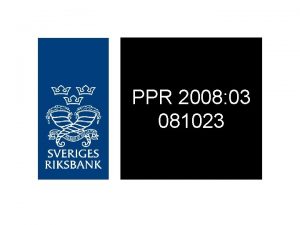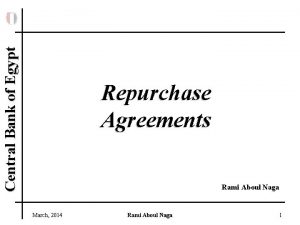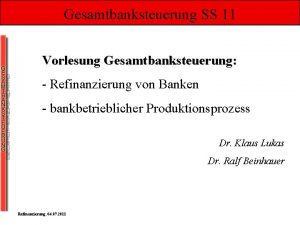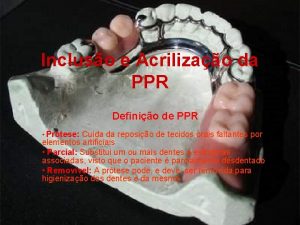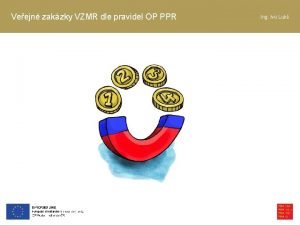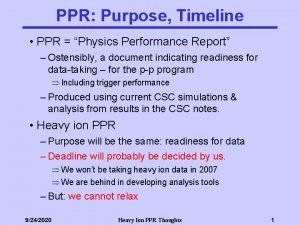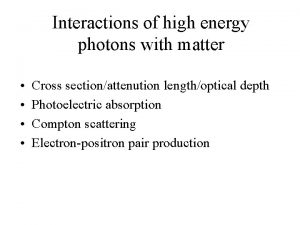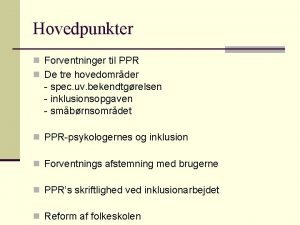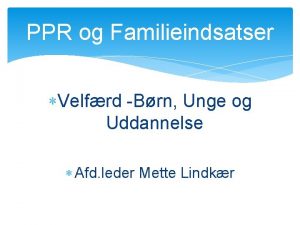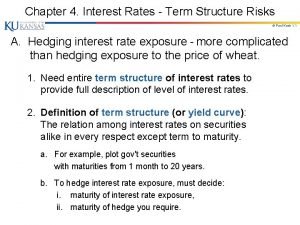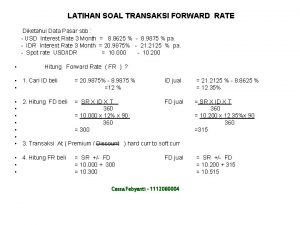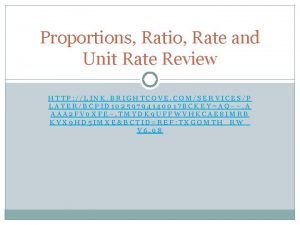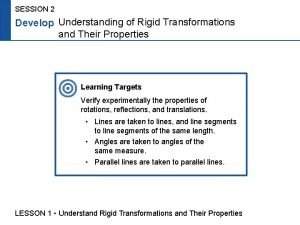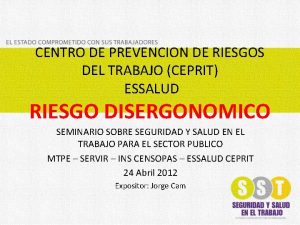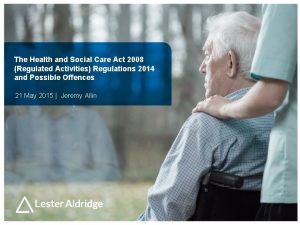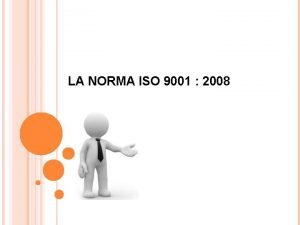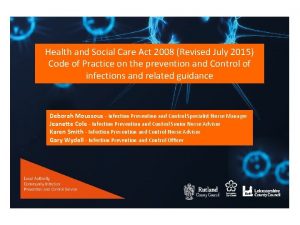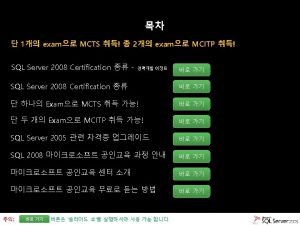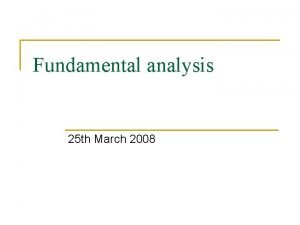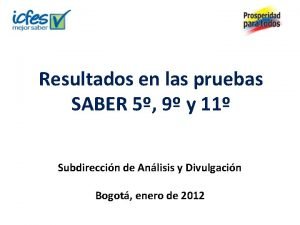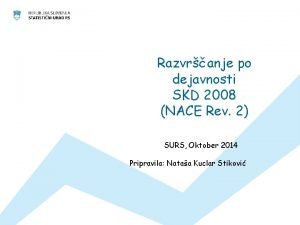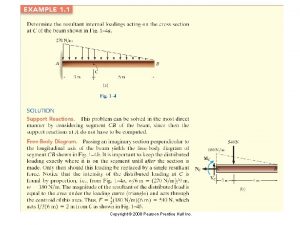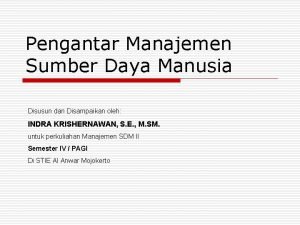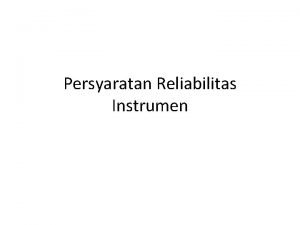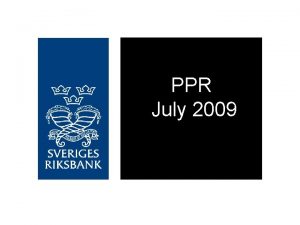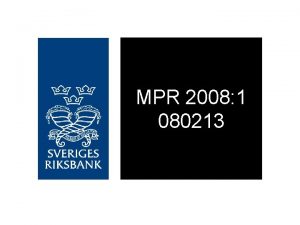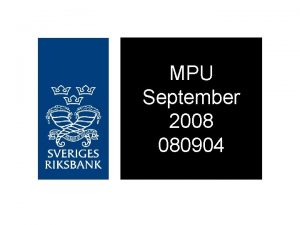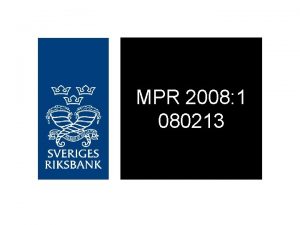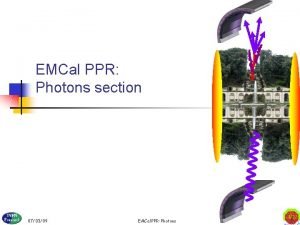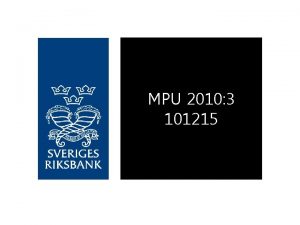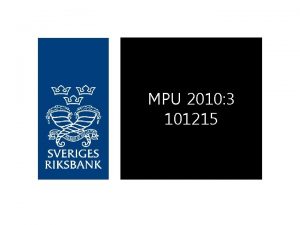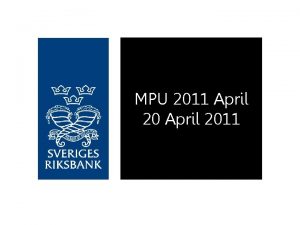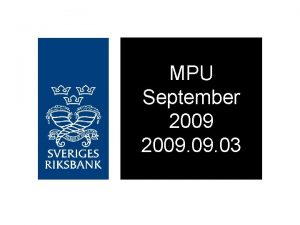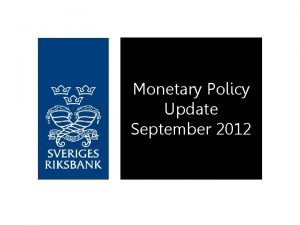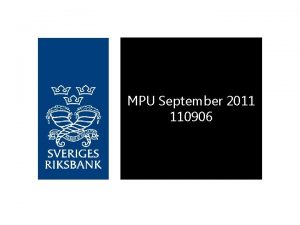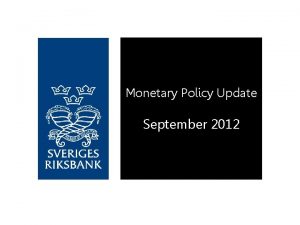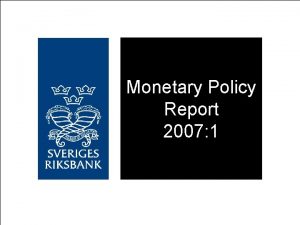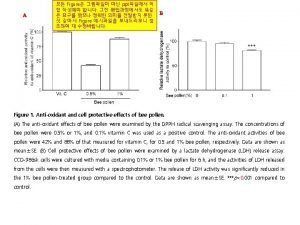PPR 2008 03 081023 Figure 1 Repo rate

































































































- Slides: 97

PPR 2008: 03 081023

Figure 1. Repo rate with uncertainty bonds Per cent, quarterly averages Source: The Riksbank

Figure 2. CPI with uncertainty bands Annual percentage change Sources: Statistics Sweden and the Riksbank

Figure 3. GDP with uncertainty bands Annual percentage change, seasonally-adjusted data Sources: Statistics Sweden and the Riksbank

Figure 4. Difference between interbank rates and government bond rates (TED spread) Basis points Sources: Reuters Eco. Win and the Riksbank

Figure 5. Policy rates and three-month interbank rates in the USA and Sweden Per cent Sources: Reuters Eco. Win and the Riksbank

Figure 6. Stock market movements Index, 04. 01. 99 = 100 Source: Reuters Eco. Win

Figure 7. GDP abroad TCW-weighted, annual percentage points Note. Broken lines represent the Riksbank's forecast. Sources: National sources and the Riksbank

Figure 8. Oil price, Brent crude USD per barrel, future price Sources: Intercontinental Exchange and the Riksbank

Figure 9. Monetary policy in the euro area and the USA Per cent Sources: Reuters Eco. Win and the Riksbank

Figure 10. GDP for the United States and the euro area Quarterly changes in per cent calculated in annualised terms, seasonally-adjusted data Sources: Eurostat, Bureau of Economic Analysis and the Riksbank

Figure 11. GDP Quarterly changes in per cent calculated in annualised terms, seasonally-adjusted data Note. Broken lines represent the Riksbank’s forecast. Sources: Statistics Sweden and the Riksbank

Figure 12. Exchange rate movements SEK per euro Source: Reuters Eco. Win

Figure 13. TCW exchange rate Index, 18. 11. 92=100 Note. Broken lines represent the Riksbank’s forecast. Source: The Riksbank

Figure 14. Export Quarterly changes in per cent calculated in annualised terms, seasonally-adjusted data Note. Broken lines represent the Riksbank’s forecast. Sources: Statistics Sweden and the Riksbank

Figure 15. Household’s disposable incomes, consumption and saving ratio Annual percentage change, fixed prices and percentage of disposable income Sources: Statistics Sweden and the Riksbank

Figure 16. Fixed gross investment Quarterly changes in per cent calculated in annualised terms, seasonally-adjusted data Note. Broken lines represent the Riksbank’s forecast. Sources: Statistics Sweden and the Riksbank

Figure 17. General government net lending Per cent of GDP Note. Broken bars represent the Riksbank’s forecast. Sources: Statistics Sweden and the Riksbank

Figure 18. Number of hours worked Index, quarter 1 2000 =100, seasonally-adjusted data Note. Broken lines represent the Riksbank’s forecast. Sources: Statistics Sweden and the Riksbank

Figure 19. Labour force and number of employed Thousands, seasonally-adjusted data Sources: Statistics Sweden and the Riksbank

Figure 20. Unemployed Percentage of the labour force, seasonally-adjusted data Sources: Statistics Sweden and the Riksbank

Figure 21. Actual and trend productivity growth in the economy as a whole Annual percentage change, seasonally-adjusted data Sources: Statistics Sweden and the Riksbank

Figure 22. Unit labour costs for the economy as a whole Annual percentage change, seasonally-adjusted data Sources: Statistics Sweden and the Riksbank

Figure 23. Employment rate Employment as a percentage of the population, 16 -64 year, seasonally-adjusted data Note. Broken lines represent the Riksbank’s forecast. Sources: Statistics Sweden and the Riksbank

Figure 24. Estimated gaps Percentage deviation from the HP trend Sources: Statistics Sweden and the Riksbank

Figure 25. CPI, CPIF and CPIX Annual percentage change Note. Broken lines represent the Riksbank’s forecast. Sources: Statistics Sweden and the Riksbank

Figure 26. CPI Quarterly changes in per cent calculated in annualised terms, seasonally-adjusted data Sources: Statistics Sweden and the Riksbank

Figure 27. Repo rate Per cent, quarterly averages Note. Broken lines represent the Riksbank’s forecast. Source: The Riksbank

Figure 28. Real repo rate Per cent, quarterly averages Sources: Statistics Sweden and the Riksbank

Figure 29. CPI Annual percentage change Note. Broken lines represent the Riksbank's forecast. Sources: Statistics Sweden and the Riksbank

Figure 30. The CPIF, outcome and forecasts on different occasions Annual percentage change Note: Broken lines represent the Riksbank's forecast Source: Statistics Sweden and the Riksbank

Table 1. Inflation, annual average Annual percentage change Note. The assessment in the Monetary Policy Update in September 2008 is stated in parenthesis. Sources: Statistics Sweden and the Riksbank

Table 2. Inflation, 12 -month average Annual percentage change Note. The assessment in the Monetary Policy Update in September 2008 is stated in parenthesis. Sources: Statistics Sweden and the Riksbank

Table 3. Key figures, annual average Annual percentage change unless otherwise specified * Percentage of labor force Note. The assessment in the Monetary Policy Update in September 2008 is stated in parenthesis. Sources: IMF, Intercontinental Exchange, National Mediation Office, Statistics Sweden and the

Table 4. Repo rate forecast Per cent, quarterly averages Note. The assessment in the Monetary Policy Update in September 2008 is stated in parenthesis. Source: The Riksbank

Figure 31. GDP Annual percentage change, seasonally-adjusted data Note. Broken lines represent the Riksbank’s forecast. Sources: Statistics Sweden and the Riksbank

Figure 32. Production gap (GDP) Percentage deviation from the HP trend Sources: Statistics Sweden and the Riksbank

Figure 33. Labour market gap Percentage deviation from the HP trend Sources: Statistics Sweden and the Riksbank

Figure 34. Repo rate assumptions Per cent, quarterly averages Note. Broken lines represent the Riksbank’s forecast. Source: The Riksbank

Figure 35. Real interest rate Per cent Source: the Riksbank

Figure 36. CPI Annual percentage change Note. Broken lines represent the Riksbank’s forecast. Sources: Statistics Sweden and the Riksbank

Figure 37. TCW exchange rate Index Note. Broken lines represent the Riksbank’s forecast. Source: The Riksbank

Figure 38. Production gap (GDP) Percentage deviation from the HP trend Sources: Statistics Sweden and the Riksbank

Figure 39. Labour market gap Percentage deviation from the HP trend Sources: Statistics Sweden and the Riksbank

Figure 40. Repo rate assumptions Per cent, quarterly averages Note. Broken lines represent the Riksbank’s forecast. Source: The Riksbank

Figure 41. CPI Annual percentage change Note. Broken lines represent the Riksbank’s forecast. Sources: Statistics Sweden and the Riksbank

Figure 42. Real interest rate Per cent Source: The Riksbank

Figure 43. CPI Annual percentage change Note. Broken lines represent the Riksbank’s forecast. Sources: Statistics Sweden and the Riksbank

Figure 44. Repo rate assumptions Per cent, quarterly averages Source: The Riksbank Note. Broken lines represent the Riksbank’s forecast.

Figure 45. Real interest rate Per cent, quarterly averages Sources: Statistics Sweden and the Riksbank

Figure 46. Stock market movements and implied volatility Index, 1 January 1990=1 and per cent Sources: Standard & Poor's and Chicago Board Options Exchange

Figure 47. Two-year interest rates Per cent Note: Government bonds with approximately 2 years left to maturity. Source: Reuters Eco. Win

Figure. 48 Basis-spread and TED-spread in Sweden Per cent Source: Reuters Eco. Win

Figure 49. Monetary policy expectations in Sweden according to money market participants Per cent Sources: Reuters Eco. Win, Prospera Research AB and the Riksbank

Figure 50. Exchange rates SEK per Euro and dollar Source: Reuters Eco. Win

Figure 51. Interest rates in Sweden Per cent Sources: Reuters Eco. Win, SBAB, Statistics Sweden and the Riksbank

Figure 52. House prices and total lending to Swedish households Annual percentage change Sources: Statistics Sweden and the Riksbank

Figure 53. Money supply Annual percentage change Sources: Statistics Sweden and the Riksbank

Figure 54. Employment and private consumption in the United States Annual percentage change Sources: Bureau of Labor Statistics and Department of commerce

Figure 55. Economic indicators in the euro area Index, December 2005 = 100, respective annual percentage change Sources: European Commission and OECD

Figure 56. Konsumentpriser CPI Sources: Bureau of Labour Statistics, Eurostat and Office for National Statistics

Figure 57. CPI excluding energy and food Annual percentage change Source: OECD

Figure 58. HICP for the Euro area Annual percentage change Source: Eurostat

Figure 59. Confidence indicators in the business sector Seasonally adjusted net figures, monthly observations Source: National Institute of Economic Research

Figure 60. Purchasing managers’ index and National Institute of Economic Research’s confidence indicator for the manufacturing industry Seasonally-adjusted index and net figures Sources: Swedbank and National Institute of Economic Research

Figure 61. Retail sales and household consumption Annual percentage change Source: Statistics Sweden

Figure 62. Household financial wealth and saving Per cent of disposable income Source: Statistics Sweden

Figure 63. Households expectations for the future Net figures Source: National Institute of Economic Research

Figure 64. Gross fixed capital formation Annual percentage change Source: Statistics Sweden

Figure 65. Foreign trade with goods and fixed prices Annual percentage change, seasonally-adjusted data Note. Three-month moving averages. Sources: Statistics Sweden and the Riksbank

Figure 66. Number of employed Thousands, seasonally-adjusted data Note. Broken lines represent the Riksbank's forecast. Sources: Statistics Sweden and the Riksbank

Figure 67. Hiring plans and number of employed in the business sector Balance and annual percentage change Sources: National Institute of Economics research and Statistics Sweden

Figure 68. Proportion of firms reporting a shortage of labour Per cent, seasonally-adjusted data Source: National Institute of Economic Research

Figure 69. New and unfilled vacant jobs and redundancy notices Thousands, seasonally adjusted data Source: Swedish Public Employment Service

Figure 70. Capacity utilisation in industry Per cent, seasonally-adjusted data Sources: National Institute of Economic Research and Statistics Sweden

Figure 71. Full utilisation of companies' resources, private service industries Proportion of companies Source: National Institute of Economic Research

Figure 72. Wages in the construction, service and manufacturing sectors Annual percentage change Note. Three-month moving average. Sources: National Mediation Office and the Riksbank.

Figure 73. Wages Annual percentage change Sources: National Mediation Office and the Riksbank

Figure 74. Actual inflation (CPI) and households' and companies' expectations of inflation one year ahead Annual percentage change Source: National Institute of Economic Research and Statistics Sweden

Figure 75. The difference between nominal and real five-year rates (break-even inflation) Percentage points Sources: The Riksbank

Figure 76. Different agents' expectation of inflation one, two and five years ahead Annual percentage change Source: Prospera Research AB

Figure 77. Different agents' expectation of inflation two years ahead Annual percentage change Source: Prospera Research AB

Figure 78. Food, energy and mortgage costs in the CPI Annual percentage change Note: The weight of CPI of the respective components is given in brackets. Source: Statistics Sweden

Figure 79. Commodity prices USD, index Source: The Economist

Figure 80. Different measures of underlying inflation Annual percentage change Sources: Statistics Sweden and the Riksbank

Figure R 1. Financial balance, forecasts Per cent of GDP Sources: Ministry of Finance, National Institute of Economic Research and the

Figure R 2. Slower price increases Balance Source: The Riksbank

Table A 1. Inflation, annual average Annual percentage change Note. The assessment in the Monetary Policy Update in September 2008 is stated in parenthesis. Sources: Statistics Sweden and the Riksbank

Table A 2. Inflation, 12 -month average Annual percentage change Note. The assessment in the Monetary Policy Update in September 2008 is stated in parenthesis. Sources: Statistics Sweden and the Riksbank

Table A 3. Summary of financial forecasts, annual average Per cent, unless otherwise specified * Per cent of GDP Note. The assessment in the Monetary Policy Update in September 2008 is stated in parenthesis. Sources: Statistics Sweden and the Riksbank

Table A 4. International conditions Annual percentage change, unless otherwise specified Note. The assessment in the Monetary Policy Update in September 2008 is stated in parenthesis. Sources: IMF, Intercontinental Exchange, OECD and the Riksbank

Table A 5. GDP by expenditure Annual percentage change, unless otherwise specified *Contribution to GDP growth, percentage points Note. The assessment in the Monetary Policy Update in September 2008 is stated in parenthesis. Sources: Statistics Sweden and the Riksbank

Table A 6. Production and employment Annual percentage change, unless otherwise stated * Per cent of labour force Note. The assessment in the Monetary Policy Update in September 2008 is stated in parenthesis. Source: Employment Service, Statistics Sweden and the Riksbank

Table A 7. Wages and unit labour cost for the economy as a whole Annual percentage change, unless otherwise stated, calendar-adjusted data * Contribution to the increase in labour costs, percentage points Note. The assessment in the Monetary Policy Update in September 2008 is stated in parenthesis. Sources: National Mediation Office, Statistics Sweden and the Riksbank

Table A 8. Scenario with intensified effects of the credit crisis, annual average Annual percentage change, unless otherwise specified Note. Main scenario’s forecast in brackets. Sources: Statistics Sweden and the Riksbank

Table A 9. Scenario with weaker krona, annual average Annual percentage change, unless otherwise specified Note. Main scenario’s forecast in brackets. Sources: Statistics Sweden and the Riksbank

Table A 10. Scenario with continued high inflation, annual average Annual percentage change, unless otherwise specified Note. Main scenario’s forecast in brackets. Sources: Statistics Sweden and the Riksbank
 Repo rate formula
Repo rate formula Repo rate definition
Repo rate definition Ppr 2008 english
Ppr 2008 english Types of naga
Types of naga Repo
Repo Private suse repo
Private suse repo Callie wall
Callie wall Reverse repo definitie
Reverse repo definitie Repurchase agreement (repo) und wertpapierleihe
Repurchase agreement (repo) und wertpapierleihe 50 repo
50 repo 2008 2008
2008 2008 Ppr dentomucosoportada
Ppr dentomucosoportada Flat ppr
Flat ppr Ppr vordingborg
Ppr vordingborg Ppruqe
Ppruqe Ppr dentosoportada
Ppr dentosoportada Roslab
Roslab Tubes ppr
Tubes ppr Retenedores indirectos
Retenedores indirectos Rejilla de lengua
Rejilla de lengua Op ppr
Op ppr Ppr timeline
Ppr timeline Ppr cross
Ppr cross Conector en herradura
Conector en herradura Op ppr
Op ppr Clase 1 kennedy
Clase 1 kennedy Ppr dentosoportada
Ppr dentosoportada Ppr n
Ppr n Dentosoportada y dentomucosoportada
Dentosoportada y dentomucosoportada Ppr dentosoportada
Ppr dentosoportada Ppr uddannelse
Ppr uddannelse Nominal v. real interest rates
Nominal v. real interest rates Forward rate example
Forward rate example What is plant growth analysis
What is plant growth analysis 1 year forward rate formula
1 year forward rate formula Transaksi forward
Transaksi forward Difference between rate and unit rate
Difference between rate and unit rate Cap rate interest rate relationship
Cap rate interest rate relationship Real exchange rate formula
Real exchange rate formula A transformation is an operation that
A transformation is an operation that 13 figure grid reference
13 figure grid reference Understand rigid transformations
Understand rigid transformations Coordinate plane jeopardy
Coordinate plane jeopardy 22 mai 2008
22 mai 2008 2008 floods mackay
2008 floods mackay Microsoft robotics developer studio 2008
Microsoft robotics developer studio 2008 Upgrade 2003 to 2008
Upgrade 2003 to 2008 T. trimpe 2008 http //sciencespot.net/
T. trimpe 2008 http //sciencespot.net/ Portaria 377/2008
Portaria 377/2008 Veri toplama teknikleri
Veri toplama teknikleri Which statement best describes apartheid
Which statement best describes apartheid Traslocone sec
Traslocone sec Rm 375-tr-2008 iluminacion
Rm 375-tr-2008 iluminacion Lingkungan msdm (mondy 2008)
Lingkungan msdm (mondy 2008) 2008 pearson education inc
2008 pearson education inc Health and social care act regulated activities
Health and social care act regulated activities Norma iso 9001:2008
Norma iso 9001:2008 Uk 2008
Uk 2008 Nom 001 stps 2008 edificios locales e instalaciones
Nom 001 stps 2008 edificios locales e instalaciones Gascornedo
Gascornedo 2008 pearson education inc
2008 pearson education inc Xxxxxxx 2011
Xxxxxxx 2011 Copyright 2008
Copyright 2008 Hitachi ams 2100
Hitachi ams 2100 Nasa june 19 2008
Nasa june 19 2008 Eureka puc pr
Eureka puc pr Health and social care act 2008
Health and social care act 2008 2008 in roman numerals
2008 in roman numerals Sql server 2008 certification
Sql server 2008 certification Melanie nind 2008
Melanie nind 2008 25 march 2008
25 march 2008 Resultados icfes 2008
Resultados icfes 2008 Dt 2008
Dt 2008 Resolucion sbs 11356
Resolucion sbs 11356 Nasa 2008
Nasa 2008 Fbő tanfolyam
Fbő tanfolyam Ipam windows server 2008
Ipam windows server 2008 Background of jollibee
Background of jollibee Cpa/skd (3-mestna)
Cpa/skd (3-mestna) Prentice hall inc
Prentice hall inc 나모웹에디터 2008
나모웹에디터 2008 Iso/iec 24762:2008
Iso/iec 24762:2008 Fuwa mascots beijing 2008
Fuwa mascots beijing 2008 Linea 1503
Linea 1503 Lei11.788/2008
Lei11.788/2008 Pearson education limited 2008
Pearson education limited 2008 Sql server 2008 auditing best practices
Sql server 2008 auditing best practices March 7 2008
March 7 2008 Copyright 2008
Copyright 2008 2008
2008 T. trimpe 2008 http://sciencespot.net/
T. trimpe 2008 http://sciencespot.net/ Layers and components of the artery wall
Layers and components of the artery wall Lingkungan msdm (mondy 2008)
Lingkungan msdm (mondy 2008) Decret 181
Decret 181 Sukardi 2008
Sukardi 2008 2008 pearson education inc
2008 pearson education inc Medina 2008
Medina 2008 Gsm gearbox
Gsm gearbox


